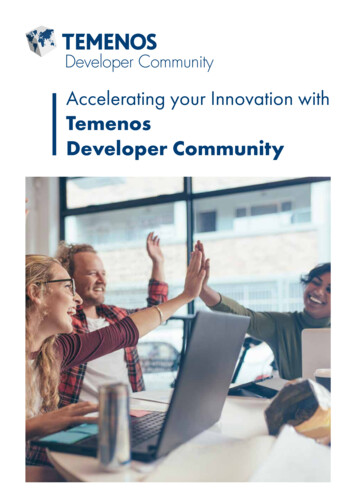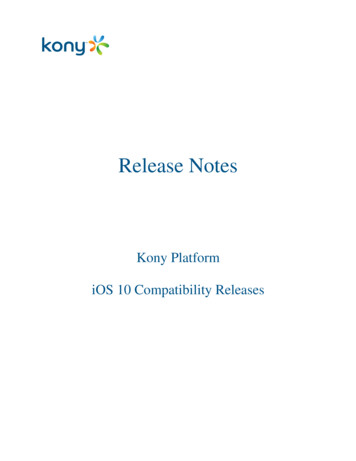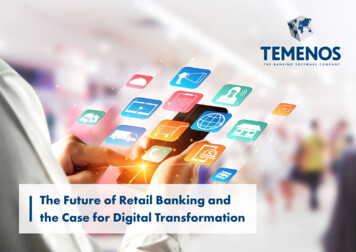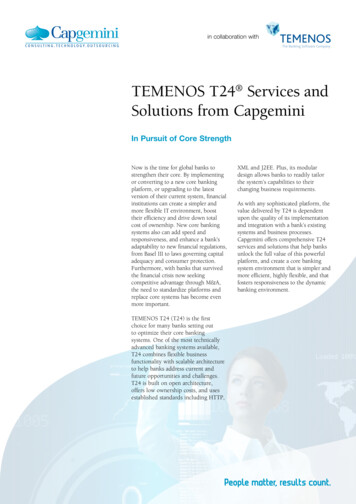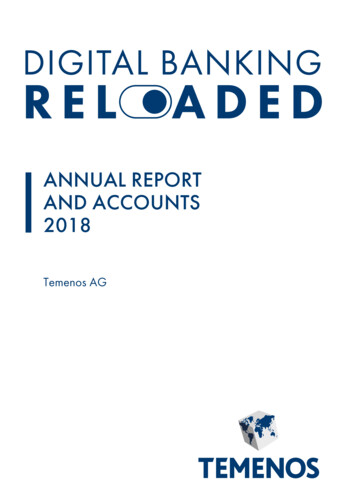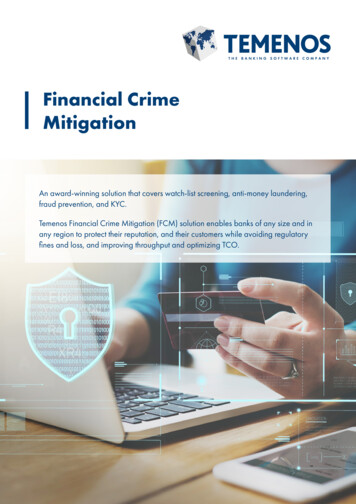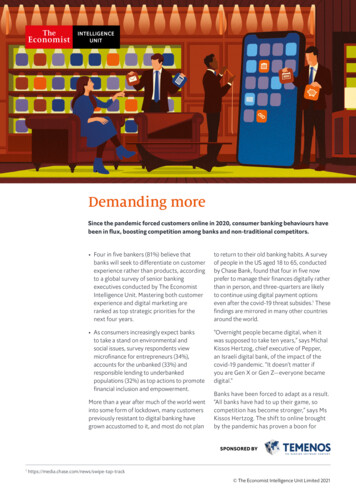
Transcription
Demanding moreDemanding moreSince the pandemic forced customers online in 2020, consumer banking behaviours havebeen in flux, boosting competition among banks and non-traditional competitors. Four in five bankers (81%) believe thatbanks will seek to differentiate on customerexperience rather than products, accordingto a global survey of senior bankingexecutives conducted by The EconomistIntelligence Unit. Mastering both customerexperience and digital marketing areranked as top strategic priorities for thenext four years.to return to their old banking habits. A surveyof people in the US aged 18 to 65, conductedby Chase Bank, found that four in five nowprefer to manage their finances digitally ratherthan in person, and three-quarters are likelyto continue using digital payment optionseven after the covid-19 threat subsides.1 Thesefindings are mirrored in many other countriesaround the world. As consumers increasingly expect banksto take a stand on environmental andsocial issues, survey respondents viewmicrofinance for entrepreneurs (34%),accounts for the unbanked (33%) andresponsible lending to underbankedpopulations (32%) as top actions to promotefinancial inclusion and empowerment.“Overnight people became digital, when itwas supposed to take ten years,” says MichalKissos Hertzog, chief executive of Pepper,an Israeli digital bank, of the impact of thecovid-19 pandemic. “It doesn’t matter ifyou are Gen X or Gen Z—everyone becamedigital.”More than a year after much of the world wentinto some form of lockdown, many customerspreviously resistant to digital banking havegrown accustomed to it, and most do not planBanks have been forced to adapt as a result.“All banks have had to up their game, socompetition has become stronger,” says MsKissos Hertzog. The shift to online broughtby the pandemic has proven a boon forSPONSORED BY1https://media.chase.com/news/swipe-tap-track The Economist Intelligence Unit Limited 20211
Demanding moredigital-only banks. As of January 2021, 14mBrits (27% of UK adults) had a digital-onlybank account—16% growth from January2020 and a threefold increase compared toJanuary 2019.The shift has brought forward expectationsof the demise of the branch, traditionallythe centre of the retail banking experience.According to our annual global bankingsurvey, supported by Temenos, 65% ofbankers now believe that the traditionalbranch-based banking model will be“dead” within five years, while 71% expectcash to represent less than 5% of all retailtransactions globally by 2025.Senior executives report that technologyis driving customer experience. Surveyrespondents cited changing customerbehaviours and demands around digitalbanking, the new technologies needed tounderstand and serve customers better, andregulation on digital technology (includingdata protection, which dictates how bankscan interact with customers and their data) asthe top three trends that will have the biggestimpact on banks in their countries by 2025.Consequently, survey respondents’ topstrategic priorities by 2025 are all customerfocused: improving customer experience andengagement, including personalisation andintimacy; mastering digital marketing; andmigrating client usage from physical to digitalchannels.At Pepper, the focus has been personalisation.When individual customers open the bank’sapp, they see a homepage personalisedto their specific actions, says Ms KissosHertzog. “Different customers will seedifferent products, will receive differentmarketing.” The goal is a “segment of one”,tailoring the experience precisely to theindividual consumer based on their activityand preferences. “The more personalised theservice is, the more engaged customers are.”Technology investmentAccording to survey respondents, banks’ topinvestments in customer-related technologyFigure 1. What are the top strategic priorities for your company by 2025?Select up to two.0%5%10%15%20%25%Improving customer experience and engagement (includingpersonalisation, intimacy)35%30.5Mastering digital marketing28.5Migrating client usage to digital from physical channels26.9Improving product agility (the ability to launch new products)26.2Launching or implementing an open banking strategy20.3Modernizing core processing systems18Cutting costs or improving margins17Talent acquisition and retentionResponding to regulatory requirements30%12.19.2 The Economist Intelligence Unit Limited 20212
Demanding moreTechnology is not the target,it’s a means to an end.Michal Kissos Hertzog, chief executive,Pepperinclude developing artificial intelligence (AI)platforms, such as digital advisors and voiceassisted engagement channels, and advancedand predictive data analytics for customerexperience.Adoption of this technology starts withdata, says Ms Hertzog. “Banks are sitting ona humongous amount of data, but they arenot doing a good job [of using it],” she says. “Iwant to use data to give customers a betterunderstanding of their money, to help themdecide how to save, to budget, whether theyshould invest in the stock market.”But she cautions against focusing investmenton specific technologies just because they arethe latest trend. “I’ve never heard my userssaying, ‘I chose you because you have the bestartificial intelligence of all banks’. What theycare about is that they will have good service,that they’ll see the benefits from their bank,and that we meet their needs,” she says.“When we speak about technology, it’simportant to understand that the technologyis not the target, it’s a means to an end. Ofcourse, we have to have great AI, and weare implementing machine learning andblockchain—we’re doing all of that. But weare doing all of that in order to give the bestcustomer experience.”Competition and collaborationAt Fifth Third Bank in the US, the focus hasbeen on supporting open banking. “We’vebeen investing in this space substantially forthe last five years and expect to double ourinvestment over the next two,” says MelissaStevens, executive vice president and chiefdigital officer. “The foundational elements ofopen banking—modularity in the value chain,flexible technical and business architecture,and portable data—represent a shared visionacross the enterprise and are core to what webuild across the bank.”“We have a few models to best meet the needsof our customers—from leveraging enablersfrom fintechs and vendors to building or joiningplatforms to distribute offers beyond bankingservices and package products and servicesprovided by third parties,” says Ms Stevens.“Increasingly, we view the way to deliver on ourvision is by creating and participating in openecosystems—acting both as a distributor ofothers’ products and by distributing our ownproducts through others’ channels.”Fifth Third is not alone in its efforts to takeadvantage of the opportunities presentedby open banking to improve customerexperience. According to respondents toour survey, one top innovation strategyis giving customers the option to connect The Economist Intelligence Unit Limited 20213
Demanding moreFigure 2. What is the primary way in which you see your current digital business evolvingover the next 12-24 months?Select one .0%5%10% 15% 20% 25% 30% 35% 40% 45% 50%Acting as a true digital ecosystem (offering own andthird-party banking and non-banking products andservices to own customers as well as to other financialservices organisations)46.6Maintaining own product offerings and becoming anaggregator of third-party banking and/or non-bankingproducts (PFM comparison websites, etc.)27.2Becoming an aggregator of third-party products andservices only (PFM comparison websites, etc.)11.8Developing a niche proposition for own customers11.5Figure 3. Which non-traditional entrants to the banking industry will be your company’s biggestcompetitors by 2025?Select up to two.0%5%10% 15% 20% 25% 30% 35% 40% 45% 50%Payment players (eg, PayPal, Alipay, Apple Pay, Square,Ripple, WorldPay, Visa, Faster Payments)45.2Technology and e-commerce disruptors (eg, Google,Facebook, Alibaba, Microsoft, Apple)35.7Partnerships between technology giants and fintechs(eg, Financial Innovation Now)26.6Peer-to-peer lenders and alternative finance providers(eg, private debt, VC)20.7Neo-banks (eg, Varo, Starling, N26, Fidor, Five Degrees,Monzo, Tide)20Robo-advisers/automated wealth management services15.4Non-financial service firms (eg, i.e. retailers, telco,accounting software, invoice discounting, e-procurement)Aggregators and /or platforms (eg, comparison sites,Bud, Cleo, Yolt)11.88.5 The Economist Intelligence Unit Limited 20214
Demanding moretheir bank data with third-party providersthough open bank hub initiatives. To achievethat, almost half (47%) plan on evolving theirdigital business over the next 12-24 monthsto act as a true digital ecosystem, offeringtheir own and third-party banking, andnon-banking products and services, to theirown customers, as well as to other financialservices organisations. A further 27% reportthat they will maintain their own productofferings and become an aggregator of thirdparty banking and/or non-banking products.think that’s really an opportunity, not just forthe fintechs, but for the banks as well.”For example, TSB, a UK bank, offers itspersonal customers a “marketplace”, includingproducts from Wealthify, ApTap, and Legal& General, while business clients can accessservices from Square and Enterprise Nation.Digital-only Starling Bank offers an even widerrange of third-party products and servicesacross insurance, pensions, savings andinvestments, mortgages, credit scores, andloyalty programmes—including the additionof the UK’s largest digital wealth manager,Nutmeg, in December 2020.Despite the shuttering of physical shops,restaurants and entertainment venues duringthe pandemic, transactions processed byPayPal, a payments platform, leapt by 26%in the second quarter of 2020, to 3.7bn, asmerchants moved online.As a digital-only bank, Pepper has always beenopen to collaboration. “I don’t think I needto develop everything by myself,” says MsHertzog. “The core is mine, but for additionalservices I will collaborate to bring in the besttechnology. For example, we use an Israelifintech called Eco-Bill, which our customerscan use to pay their bills. They gave us a greattool and through working with us they havebeen able to improve it. We both win. I’mreally looking forward to collaborating withmore Israeli fintechs.”Ms Kissos Hertzog believes that collaborationwith fintechs can help to bring a true customerfocus to banks. “The young start-ups, they seethings differently—they are much faster thantraditional banks and they have one singlefocus: the customer. It’s not something youhave to teach them, it’s within their being. I23Fintechs are seen not just as collaboratorsbut as competition, particularly in payments.Digital wallet services such as Apple Pay,Google Pay and Samsung Pay are increasinglyused for online and in-store payments. Digitalwallets now account for 32% of all onlinepayments in the UK—more than debit or creditcards (29% and 21% respectively)—and thisnumber is expected to rise to 40% by 2024.2And online payment innovation is rife. “Buynow, pay later” (BNPL) services, pioneered bythe likes of Affirm and Klarna, have explodedin popularity, driven in part by uncertaintyaround employment and personal finances.Algorithms use publicly available creditinformation and details of the size, type andtiming of the purchase to calculate the chanceof fraud, and offer extended-payment plans.Many online retailers are integrating theseservices into their payment pages, and theycover the cost of the interest as if it was a salesdiscount. These services became very popularduring the pandemic, with Klarna alone nowclaiming to have 90m customers. The firmis now the largest private fintech in Europe,valued at US 46bn—four times what it wasworth in September 2020.3 PayPal, whichlaunched several BNPL offerings in 2020, suchas Pay in 4x (in France) and Pay in 3 (in theUK), says that average order volumes morethan double when compared with standardpurchases. Nine months after launch, PayPalnow has over 20m BNPL ke-banks-will-not-protect-consumers-162625 The Economist Intelligence Unit Limited 20215
Demanding more6Figure 4. Which aspects of financial inclusion/empowerment is your company considering in thenext 1-3 years, as a strategic, actionable business opportunity?Select up to two.AFRICA AND MIDDLE EASTASIAMicro-finance for entrepreneursBudgeting /personal finance management44Deposits (current/saving accounts) for an unbanked population38.2Responsible lending to an ‘under-banked’ population36.430Responsible lending to an ‘under-banked’ populationShadow banking products (eg mobile money services)36.426Budgeting /personal finance managementDeposits (current/saving accounts) for an unbanked population32.724Shadow banking products (eg mobile money services)Micro-finance for entrepreneurs30.924Government-to-person (G2P) paymentsGovernment-to-person (G2P) payments16.424EUROPELATIN AMERICABudgeting /personal finance managementMicro-finance for entrepreneurs36.4Responsible lending to an ‘under-banked’ population42Deposits (current/saving accounts) for an unbanked population31.242Micro-finance for entrepreneursResponsible lending to an ‘under-banked’ population29.936Deposits (current/saving accounts) for an unbanked populationShadow banking products (eg mobile money services)2632Shadow banking products (eg mobile money services)Budgeting /personal finance management24.730Government-to-person (G2P) paymentsGovernment-to-person (G2P) payments16.910NORTH AMERICADeposits (current/saving accounts) for an unbanked population37Shadow banking products (eg mobile money services)34.2Responsible lending to an ‘under-banked’ population28.8Budgeting /personal finance management27.4Micro-finance for entrepreneurs27.4Government-to-person (G2P) payments23.3 The Economist Intelligence Unit Limited 2021
Demanding moreWhat customers wantConsumers expect a great customerexperience, but they are also increasinglydemanding that companies, including theirbanks, are responsible and take a stand onissues that are important to them, such ascombating climate change, and promotingdiversity and financial inclusion. This isparticularly true of younger generations.According to the 2020 Zeno Strengthof Purpose Study, 70% of Gen Zers andMillennials globally believe that a brand shouldhave a purpose that they personally believein, compared with just 48% of Baby Boomers,and consumers of all age groups are four timesmore likely to purchase from a company thatthey believe has a strong purpose.4This means not just giving token supportto causes but actively integrating beliefsthroughout the organisation—from changingproducts and services to increase inclusion;to improving diversity among employees,management and suppliers; to reducingcarbon footprint.At Fifth Third Bank, its inclusion initiativesinclude commitments relating to employees,customers and the communities in which itoperates, focusing on equitable outcomesfor all. “For example, we want to ensure thediversity of the Bank’s workforce reflectsthe markets it serves. We also expect 25%of new branches will be built in majorityminority tracts and low- and moderateincome communities. And we are increasingaccessibility through innovation, providingwider access to business and consumerloans, expanding accessible tools for financialeducation and developing innovative bankingsolutions for the unbanked and underbanked.”4For survey respondents, microfinance forentrepreneurs, deposits for unbankedpopulations and responsible lending tounder-banked populations are the top actionsthat they are considering in the next one tothree years to promote financial inclusionand empowerment. In Europe and Asia, thefocus is on budgeting and personal financemanagement applications for customers (seeFigure 4).Branching out?As the world emerges from covid-19restrictions, people are examining thepandemic’s long-term impact on every facet oflife. While some are nostalgic for the good olddays, anticipating a rush back to the office andin-person events, others say that there is nogoing back and predict that the convenienceoffered by digital will forever alter everyaspect of life.However, Ms Stevens sees a middle way forretail banking. “As a relationship bank, webelieve in the future of branch-based banking,”she says. “However, we think it will continueto evolve. We’ve opened about 50 ‘NextGen’branches in the past 18 months and plan toopen another 50 in the next 18 months. Weknow how important the branch—and thehuman connection beyond just a phone callwith a banker can be. We also know thatdigital banking remains important to people,too. They need a mix. They want to bankwhen they want, how they want and wherethey want. You cannot have a branch withoutstrong digital presence and ngth-purpose The Economist Intelligence Unit Limited 20217
Demanding moreWhile every effort has been taken to verify the accuracy of thisinformation, The Economist Intelligence Unit Ltd. cannot accept anyresponsibility or liability for reliance by any person on this report orany of the information, opinions or conclusions set out in this report.The findings and views expressed in the report do not necessarilyreflect the views of the sponsor. The Economist Intelligence Unit Limited 20218
The Economist Intelligence Unit Limited 2021 Demanding more 3 include developing artificial intelligence (AI) platforms, such as digital advisors and voice-assisted engagement channels, and advanced and predictive data analytics for customer experience. Adoption of this technology starts with data, says Ms Hertzog. "Banks are sitting on
